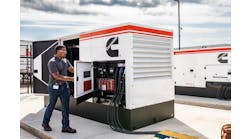Designing Microgrids: Evaluating Parameters for Reliable, Cost-Effective and Optimized Power Solutions
As distributed generation, energy storage and controller technology advance, microgrids are becoming more prevalent and viable. The capability to push power into and draw power from the grid while also independently supplying power to a local load offers significant advantages in terms of reliability, control and cost minimization. Below is a brief overview of the parameters to consider when designing a microgrid.
Considerations for load profiles and power sources
Two of the most prominent aspects of microgrid design to consider are:
1) What type of load profile exists? For example, how does power consumption vary over regular intervals such as an hour, a day, a month or a year?
2) What power sources are available to supply the load?
Load profile
A typical load profile features a base load, which represents the minimum amount of power consistently consumed, a peak load, which denotes the maximum power consumption within a specific interval, and intermediate loads that transition between the base load and peak load. The specifics of the magnitude of each type of load, typical durations of each, and how quickly transitions must be made characterize a load profile and will dictate important parameters for the energy sources supplying the microgrid.
Power sources
Hydrocarbon generators, renewable sources, energy storage systems and utility connections are among the available options for powering microgrids, each with its own set of benefits and drawbacks.
Hydrocarbon generators can provide base power and adapt quickly to changes in load. However, they experience reduced fuel efficiency and can suffer from carbon buildup when loads are excessively high or low.
Renewables, on the other hand, do not rely on traditional fuel but are limited by their time-constrained power output. Typically, renewables are paired with battery storage to align power supply with demand.
Energy storage systems are valuable for balancing load profiles, but they involve large capital expenditures. Moreover, these systems tend to be application-specific, offering a subset of features such as large energy capacity, rapid response to power demand fluctuations, efficient energy storage or compact physical size but not all these qualities simultaneously.
While utility connections offer versatility, purchased power can be costly. One of the advantages of a microgrid is the ability to generate power during a utility outage because relying solely on the grid can be counterproductive.
In addition to the above considerations, matching or adapting power sources and loads based on the characteristics of the power being produced and consumed is crucial. For instance, a generator may produce three-phase 480-volt alternating current power, which is ideal for supplying three-phase 480-volt motors. However, if the same generator is to power a load that requires direct current power at a different voltage level, such as a battery, it would necessitate power conversion and conditioning equipment to ensure compatibility.
Optimizing power supply and control
Beyond load analysis and equipment selection, the control scheme is another crucial aspect of microgrid design. While it may be sufficient to connect a motor and generator to the same power bus and allow them to run with minimal supervision, incorporating more sophisticated control systems may have advantages. Controllers, often in the form of small computers, allow for the ability to respond to various situations. They can be implemented at the individual source level as well as at higher distribution levels to optimize the coordination of power sources with the load demand.
A controller can possess the capability to detect a rapid increase in load, then direct a power source to meet the new demand and subsequently reduce supply as the demand returns to the base load. Furthermore, the controller may be able to assess whether it is more cost-effective to fulfill the power demand through on-site generation or to procure power from the grid, thereby reducing operational expenses. The ability to buy and sell power, taking advantage of market fluctuations through arbitrage, is a benefit of independent generation and serves as a driving force for utility interconnection when implementing a microgrid. However, the cost of implementing more advanced control systems must be carefully evaluated in relation to the benefits of enhanced adaptability and savings achieved through market exchange.
When it is beneficial, this interconnection often takes the form of an automatic transfer switch (ATS). An ATS performs key functions that allow optimal power supply to a load when multiple sources are available. These functions include automatically isolating the grid from local sources and the load in the event of a utility outage, as well as isolating local sources from the grid and the load in the event of a local fault. Additionally, an ATS has the capability to control power flow by determining the proportion of load demand met by local sources versus the grid. This feature plays a role in the arbitrage process, enabling effective management of power distribution.
Conclusion
The specifics of design parameters will always need to be adapted and expanded to cater to unique needs, and they will evolve throughout the project. By considering the fundamentals of load, source and control, Mesa Solutions has built a foundation that enables us to ask further questions and dive into the more intricate aspects of electrical design as it pertains to microgrids.








